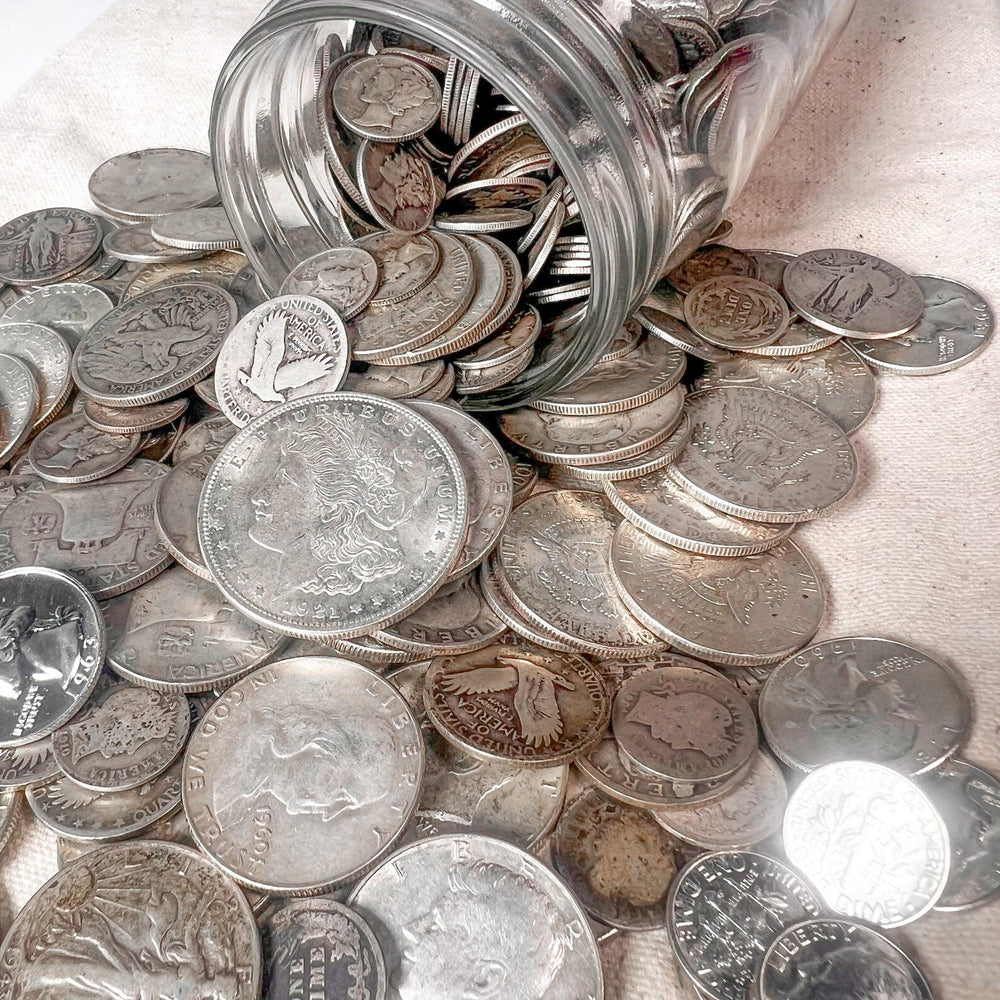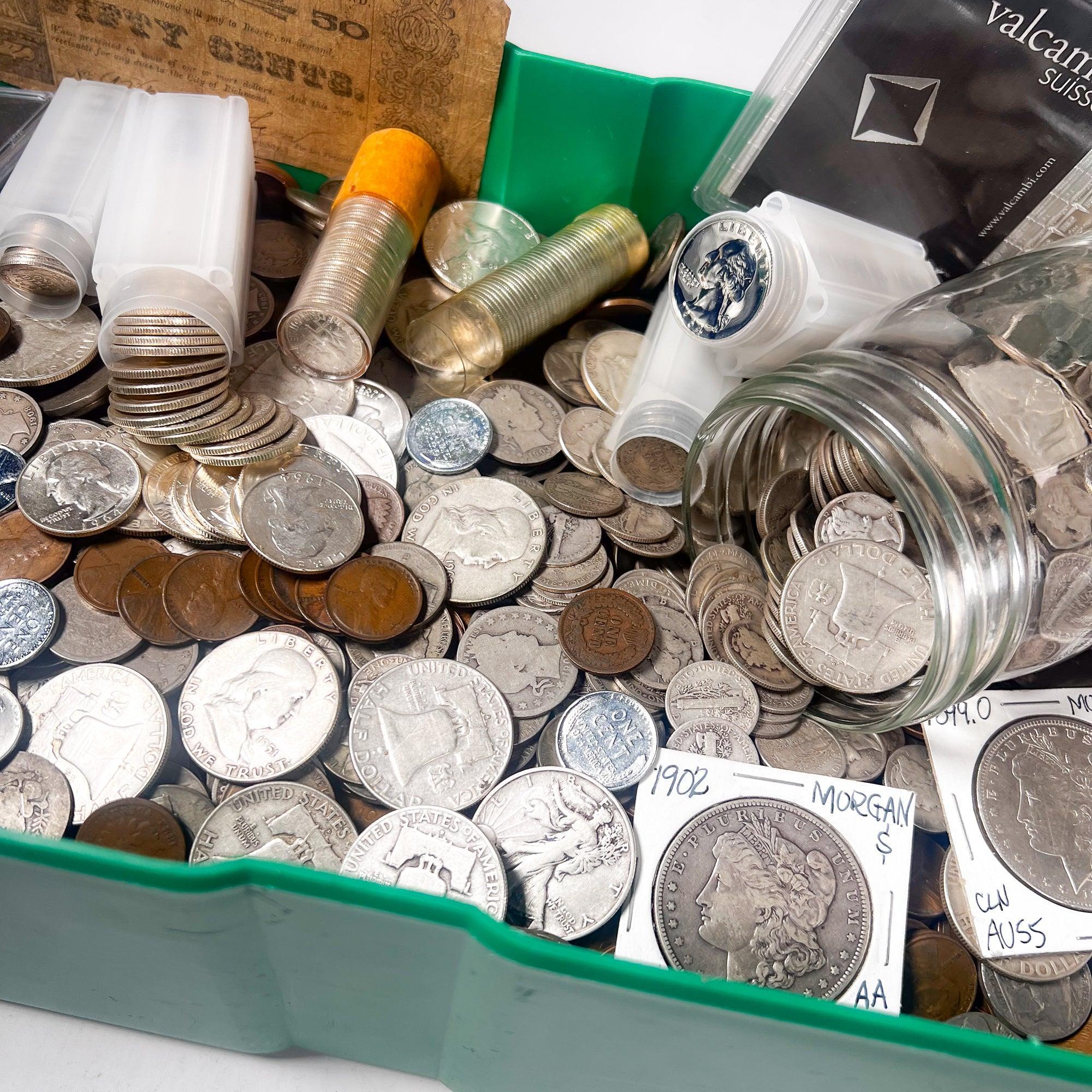Safeguarding Your Investment: How to Identify Counterfeit 90% Silver U.S. Coins and Avoid Low Returns
The market for 90% silver U.S. coins is a treasure trove for investors and collectors, but it’s also fraught with risks. Counterfeiters and scams threaten to erode your capital, making vigilance essential.
This guide, Safeguarding Your Investment: How to Identify Counterfeit 90% Silver U.S. Coins and Avoid Low Returns, equips you with actionable strategies to authenticate coins, spot fakes, and avoid low-return traps. By mastering precise authentication methods and partnering with trusted sources, you can protect your investment and ensure long-term profitability.
Why 90% Silver U.S. Coins Matter
The Appeal of 90% Silver
Known as "junk silver," pre-1965 U.S. dimes, quarters, and half-dollars (90% silver, 10% copper) offer a unique blend of history, intrinsic value, and numismatic potential.
-
Historical Significance: Coins like Mercury Dimes and Walking Liberty Half-Dollars connect to America’s past, from the Great Depression to World Wars, adding collectible appeal.
-
Intrinsic Value: Their silver content hedges against inflation and economic uncertainty, offering tangible security.
-
Numismatic Premiums: Rare dates or high-grade coins can fetch prices far above their melt value.
Composition & Purity
-
90% Silver, 10% Copper Alloy: Ensures durability and intrinsic worth, with copper adding hardness and a subtle reddish tint.
-
Melt Value: Each $1.00 face value contains ~0.715 troy ounces of silver. At $25.00/oz, this equals ~$17.88.
Common Denominations
-
Dimes:
-
Mercury (1916–1945): Collectible, with key dates like 1916-D.
-
Roosevelt (1946–1964): Common, ideal for bulk silver.
-
-
Quarters:
-
Standing Liberty (1916–1930): Prized for design and rarity.
-
Washington (1932–1964): Workhorse of junk silver.
-
-
Half-Dollars:
-
Walking Liberty (1916–1947): Iconic and collectible.
-
Franklin (1948–1963): Solid silver investment.
-
Kennedy (1964): Only 90% silver year, distinct from later 40% silver issues.
-
Melt vs. Numismatic Value
-
Melt Value: Calculated as (Silver Weight) x (Spot Price). E.g., a quarter (0.1808 oz) at $25.00/oz = $4.52.
-
Numismatic Value: Driven by rarity, condition, and demand. A 1916-D Mercury Dime can fetch thousands, far exceeding its ~$1.80 melt value.
The Threat of Counterfeit Coins
Why Counterfeits Exist
-
Profit Motives: Fakes made from cheap metals (e.g., copper, lead) yield huge markups.
-
Sophisticated Techniques: Modern fakes use 3D scanning, CNC machining, and electroplating to mimic genuine coins.
-
Market Demand: High silver prices attract new investors, creating opportunities for fraudsters.
Global Fake Sources
-
Chinese Fakes: Advanced operations produce near-perfect replicas, mimicking wear and toning.
-
Entry Points: Fakes infiltrate via online marketplaces (e.g., eBay, Etsy), private sales, or even legitimate dealers unknowingly reselling counterfeits.
Impacts
-
Financial Loss: A $1,000 bag with 10% fakes loses $100.
-
Market Trust: Fakes erode confidence, impacting liquidity.
-
Legal Risks: Passing counterfeits, even unknowingly, can lead to fraud accusations.
Junk Silver Risks
Bulk "junk silver" purchases are prime targets for mixing fakes due to their volume, making individual inspection challenging. Without vetting, you risk significant losses.
Authentication Tests for 90% Silver Coins
Weight Test
-
Tool: High-precision digital scale (0.01g accuracy).
-
Standards:
-
Dime: 2.50g
-
Quarter: 6.25g
-
Half-Dollar: 12.50g
-
-
Tolerances: ±0.03–0.04g for wear or mint variance.
-
Red Flags: Significant underweight (e.g., 5.8g quarter) or overweight coins suggest base metals.
Dimensions Test
-
Tool: Digital calipers (0.01mm accuracy).
-
Standards:
-
Dime: 17.91mm diameter, 1.35mm thickness
-
Quarter: 24.26mm diameter, 1.75mm thickness
-
Half-Dollar: 30.61mm diameter, 2.15mm thickness
-
-
Red Flags: Irregular shapes, uneven edges, or incorrect thickness/diameter.
Magnet Test
-
Principle: Silver is paramagnetic, showing no strong attraction to magnets.
-
Method: Slide a neodymium magnet over the coin; genuine silver shows no sticking.
-
Limitations: Non-magnetic base metals (e.g., copper, zinc) pass, requiring further tests.
Ping Test
-
Principle: 90% silver produces a high-pitched, sustained "ping" due to its density.
-
Method: Balance the coin on your finger or a hard surface, tap gently, and listen.
-
Results: Genuine coins ring clearly; fakes produce a dull "thud."
-
Tips: Compare with a known genuine coin for accuracy.
Specific Gravity Test
-
Principle: Measures density using Archimedes’ Principle (SG = Weight in Air / [Weight in Air - Weight in Water]).
-
Equipment: Precision scale, distilled water, thin non-absorbent thread.
-
Method:
-
Weigh coin in air (e.g., 6.25g for a quarter).
-
Submerge in water, record weight (e.g., 5.65g).
-
Calculate SG: 6.25 / (6.25 - 5.65) = ~10.42.
-
-
Expected SG: 10.3–10.4 for 90% silver.
-
Pitfalls: Avoid air bubbles, use distilled water, ensure coin doesn’t touch container.
Visual & Tactile Clues
Strike & Detail
-
Genuine Coins: Sharp details in hair, eagle feathers, and lettering.
-
Fakes: Muddy, soft, or blob-like designs; porous surfaces, casting bubbles, or mold lines.
Edge Examination
-
Reeding: Uniform, sharp grooves on dimes, quarters, and half-dollars.
-
Red Flags: Irregular, shallow, or absent reeding.
Luster & Patina
-
Genuine Coins: Exhibit cartwheel luster (uncirculated) or natural toning.
-
Fakes: Overly shiny, greasy surfaces or artificial patina that rubs off.
Date & Mint Mark
-
Red Flags: Incorrect fonts, sizes, or positioning; mismatched design elements for the year.
-
High-Risk Dates: E.g., 1916-D Mercury Dime, frequently counterfeited.
Avoiding Low-Return Investments
Junk Silver Nuances
-
Definition: Common-date, circulated coins valued for silver content.
-
Premiums: Typically 10–30% above melt value ($17.88 at $25.00/oz spot).
-
Traps: Overpaying due to high premiums, mistaking melt for numismatic value, or high transaction costs.
Common Scams
-
Too Good to Be True Deals: Below-market prices signal fakes.
-
Misrepresentation: False claims of purity, condition, or rarity.
-
High-Pressure Tactics: Rushed sales to avoid scrutiny.
-
Bulk Lots: Mixed fakes in large purchases without inspection.
Smart Buying
-
Key Dates: E.g., 1916-D Mercury Dime, 1921-S Walking Liberty Half Dollar.
-
Grading: Understand grades (e.g., VF, MS-65) to assess value.
-
Strategy: Pay low premiums for bulk silver; use TPG verification for numismatic coins.
Safeguarding with Trusted Sources
Reputable Dealers
-
Benefits: Expertise, accountability, quality control.
-
Example: Midwest Precious Metals Exchange offers NGC-certified coins.
-
Return Policies: Seek clear, reasonable terms and authenticity guarantees.
Third-Party Grading (TPG)
-
Services: PCGS, NGC, ANACS.
-
Benefits: Authenticity, grade confirmation, liquidity, and protection via slabbed holders.
-
Security Features: Holograms, certification numbers verifiable online.
Red Flags
-
High-Risk Venues: Unverified eBay/Etsy sellers, social media, or private sales.
-
Non-Specialized Sellers: Flea markets, pawn shops lacking numismatic expertise.
-
Lack of Transparency: Anonymous sellers or vague contact details.
Due Diligence
-
Reviews: Check BBB or coin forums like CoinTalk.
-
Photos & Measurements: Request high-resolution images and specs.
-
Buyer Protection: Use credit cards or platforms with guarantees (e.g., eBay’s Money Back Guarantee).
Your Protection Strategy
Protecting your 90% silver investment demands a multi-layered approach:
-
Authenticate: Use weight, dimensions, magnet, ping, and specific gravity tests.
-
Inspect Visually: Check strike, reeding, luster, and dates.
-
Source Wisely: Partner with trusted dealers like Midwest Precious Metals Exchange.
-
Stay Educated: Monitor counterfeit trends and join numismatic communities.
-
Think Long-Term: Focus on verified coins for growth, avoiding overpriced commons.
Secure your portfolio with diligence and trusted partners. Start with Midwest Precious Metals Exchange for authentic, NGC-certified 90% silver coins and build wealth with confidence.
Disclaimer: Consult a financial advisor before investing. Silver prices and numismatic values are subject to market fluctuations.












